I wasn’t expecting a great deal from PowerWash Simulator. For starters it’s yet another entrant in the now decidedly-oversubscribed Simulator “genre”, which consists of a series of increasingly desperate attempts to turn mundane everyday jobs into videogames. (I’m particularly baffled by the PC building one.) And the concept behind PowerWash Simulator is one of the most mundane of the lot: inspired by the viral success of powerwashing videos on Youtube, this is a first-person washer game where, instead of a gun, you have a power washer, and you use that power washer to clean a variety of inexplicably-filthy objects ranging from houses to ferris wheels. That is it. That is the entire game.
But it turns out that the really compelling thing about PowerWash Simulator — or the thing that really impressed me, anyway — is how it resists any temptation to overcomplicate that power washing concept, and how all-in it goes on it. It has a few game modes but the main draw of the game is the Career Mode, where you’re hired to complete a series of 36 power washing jobs and use the money earned to buy new equipment along the way. Lesser games that did not have the iron-hard self-control of PowerWash Simulator would use this as an excuse to include a whole host of unlockable gameplay gimmicks, which would have overcomplicated the core idea to the point where I suspect I would have found it far less addictive. But PowerWash Simulator smartly avoids this mistake; you start the game with a power washer and a selection of nozzles you can attach which increase the spray angle at the expense of power, and you end it having unlocked a grand total of one extra nozzle and a series of extension attachments that increase the range of your power washer, but which otherwise do not affect its power washing functionality in any way1.
This means that the core ask of the game never changes; in level one you are using a power washer to clean things, and in level thirty-six you are also using a power washer to clean things — the only real difference is that it’s a more powerful model of power washer that removes dirt faster. Refusing to change up the base mechanics at any point during Career Mode is potentially a very dangerous thing for PowerWash Simulator to be indulging in; one of the things I often complain about in my reviews is when a game repeats a mechanic so much that it becomes overfamiliar, rote, and dull, as with (to pick a random example) XCOM’s tactical battle segments. All games need to find variety from somewhere, and since PowerWash Simulator is so convinced that power washing is all it needs the only vector it really has to inject that variety is in the level design – i.e. the selection of things that you are called upon to power wash.
Fortunately for PowerWash Simulator the developers have made a very smart decision here, which is to completely disregard reality and have you clean some really, really ridiculous things. Career Mode starts you out with the standard selection of boring jobs, washing a van and a back garden and a house and a dirt bike and a slightly larger house. And while the powerwashing experience is certainly fun enough while it’s new, it is also good that these levels are clustered towards the start of the game before the novelty has worn off, as it was required to sustain me through the mild tedium of hosing yet another garage door clean. Even at this early stage, though, there’s a standout level: a children’s playground, complete with climbing frames, colourful tarmac and a purple stegosaurus slide. Spraying off all of the dirt and muck, watching these bold, primary colours emerge from behind their concealing curtain of grime, is profoundly satisfying.
If I had to guess I’d say that these were the levels that were made first (PowerWash Simulator has just come out of Early Access) and that the developers noticed how much more fun the playground was than “washing yet another suburban house”, because it’s shortly after this that things start to get extremely silly. You wash a gingerbread house and a giant shoe house in the forest. You wash a carousel and a helter skelter at the fairground. You wash a subterranean drilling machine and a monster truck that’s modelled after Catbus. Even the more mundane things become interestingly mundane; the fire helicopter and the fishing boat might have been “just” a fire helicopter and a fishing boat, but they were bright and colourful and they had lots of unique bits to clean.
And I think it is because PowerWash Simulator doesn’t overcomplicate the concept that it can afford to have such a wide variety of levels. The basic mechanics of the game are extremely well-defined and very limited in their scope: you spray water on things to make them clean. The levels themselves don’t have to cater to anything more complicated than that, and so they can be practically anything. Making one is simply a matter of thinking up an idea, making the level, slapping some dirt on top of it and then making sure it’s not too frustrating to clean – and while I certainly don’t want to talk down the amount of effort involved in doing that well, it’s this flexibility that sustains PowerWash Simulator through what turned out to be a thirty-hour campaign. If, prior to starting, somebody had told me that that’s how long I’d end up playing this thing for, I think I would have laughed in their face since I would have judged the chances of a game called PowerWash Simulator holding my attention for that long as being infinitesimally small. Yet it succeeds anyway, and that’s why I find its restrained design philosophy so impressive.
What PowerWash Simulator definitely is not, however, is perfect. It might have deftly stepped around some pretty big pitfalls in terms of not boring me to death, but there are several points of friction I repeatedly hit in the course of actually doing the power washing that really feel like they could have been avoided with much less effort, and they’re related to the sort of audience PowerWash Simulator is targeting (which it turns out I fall squarely into). This is a game that rewards tackling levels in a methodical fashion, sweeping your power washer back and forth over an object to blast away its accumulated patina of filth and reveal the gleaming metal and polished stone beneath, and ensuring that each item and area in a level is as clean as possible before moving on to the next one. And despite some levels in Career Mode not enforcing a 100% completion percentage before you move on to the next level, if you’re not the sort of person who would enjoy making a level completely clean for the sheer hell of it then you’re probably not going to enjoy PowerWash Simulator — this is, again, something that I think the developers realised midway through making it it as later levels in Career Mode do not unlock until you’ve 100%ed the previous one.
But what exactly does “100% clean” mean in the context of PowerWash Simulator, anyway? Does that mean hunting down every last pixel of dirt just to satisfy whatever compulsion is embedded deep within my brain that’s driving me to play this thing in the first place? Well, no — but also sort of; PowerWash Simulator makes one really clever decision here and then a couple of really dumb ones. Each level has an overall completion percentage that’s surfaced in the top left hand corner of the screen, but they’re also broken down into dozens (or even hundreds) of component pieces, each of which have their own completion percentage. A level component can be anything from a light to some stairs to a set of paving slabs; the skate park level has half pipe and quarter pipe components and the fortune teller’s wagon level has a crystal ball component. When you get a component to 100% it’ll flash momentarily and there’ll be a short, dopamine-infusing “ding!” sound effect indicating that you’ve finished it and can move on to the next thing — but as far as these individual level components go, “100% clean” does not mean getting rid of 100% of the dirt yourself. The smart thing that PowerWash Simulator does here is to set that 100% completion threshold artificially low at around 95-98% of the actual dirt, and then once you’ve passed that threshold any errant dirt pixels that you might have missed will automatically remove themselves as the object rounds itself up to being actually 100% clean. This gives the player a bit of wiggle room when they’re cleaning things and cuts a lot of the potential pixel-hunting pain out of the game, and in fact PowerWash Simulator arguably wouldn’t work if it didn’t do this as some of the later levels are massive and take a couple of hours to clean from start to finish, and there are some particularly stubborn types of dirt that will always leave behind a few pixels even after several sweeps with the narrow-band yellow nozzle.
But while this generous rounding-up of component cleanliness meant I didn’t have to worry about pixel-hunting quite so much, it didn’t mean I didn’t have to worry about it at all, which would have been my preferred outcome. The problems here are twofold: first is that while PowerWash Simulator might sand off the rough edges of making a component 100% clean, it affords no such conveniences for the overall level completion percentage. I would have very much liked if it had just auto-completed the level once I got things to being around 99% actually clean. As it is, the end of each level always consists of some tedious checking through a list of level components to find the ones that are stuck on 99%, and then for each one of those components some circling and checking from various angles to try and find the bits of dirt that I missed — this is almost never easy, as I was being reasonably thorough when I cleaned them the first time around and so the missing dirt is usually pretty hard to spot.
This ties into the second problem, which is that while PowerWash Simulator does provide a button that highlights dirt in yellow so that you can more easily spot any small patches that you’ve missed, it also puts several unnecessary obstacles in the way of this highlighting feature being a genuine player aid. For starters it behaves like a sonar ping instead of a toggle – pushing Tab will highlight dirt for a couple of seconds, and then the highlighting will fade and you’ll have to keep hammering Tab in order to keep track of what you’re doing. Then there’s the choice of highlight colour; yellow might have stood out quite nicely on the boring set of starter levels, but one drawback of the later level variety is that there’s zero concession made in each level’s colour palette to the dirt highlighting feature and so some of them have entire walls that are painted yellow. It won’t shock you to learn that it’s borderline impossible to find yellow-highlighted dirt on top of a yellow surface, and so I was reduced to spraying the entire thing down all over again in the hope that I’d randomly manage to hit the last dirt pixel required to get it over the line.
These two factors work in tandem to make getting each level from 99% complete to 100% rather more annoying than it really should be. PowerWash Simulator gets a few other things wrong, most notably its sense of humour, which doesn’t always completely miss but which assumes I am far more interested in the rich lore of the PowerWash Simulator universe than I really am. Fortunately it mostly exposes this to you in the form of text messages that pop up at the side of the screen while you’re working; they’re relatively easy to ignore and (very importantly) they do not block you from working at all, which is something that I’ll never take for granted again after suffering through the story segments of Hardspace: Shipbreaker. So I can forgive that, and PowerWash Simulator’s other minor mistakes — but nearly every level ending on this bum note of going down a list double and triple-checking components in order to try and find the last few patches of dirt did materially drag my enjoyment of the game down.
Happily for PowerWash Simulator its Career Mode ran out of levels before I ran out of patience. The last level was arguably Too Much (it took me nearly three hours to finish) and I really would not have been in the mood to carry on past that point, but fortunately I didn’t have to. As a result I find myself feeling substantially better-disposed towards PowerWash Simulator than I have most other games that I’ve finished this year; it’s biggest strength is an exceptional clarity of purpose that I did not expect to find in a Simulator-branded game, and which is complemented quite nicely by the imaginative level design. It definitely won’t be for everyone, and if you’re looking at the words PowerWash Simulator and thinking “Why the hell would I be interested in this?” it’s probably not for you. If you find the idea the least bit intriguing and also find yourself at a bit of a loose end during this rather barren period for interesting new releases, though, then why not give PowerWash Simulator a try? I greatly enjoyed it in spite of my initial scepticism and those few rough edges, and so hopefully you will too.
- And also the soap nozzle, which I can only assume is a funny practical joke on the part of the developers. ↩

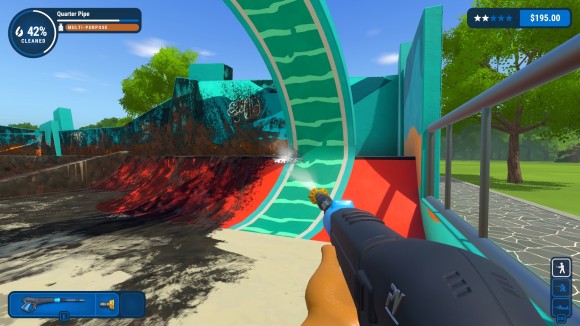
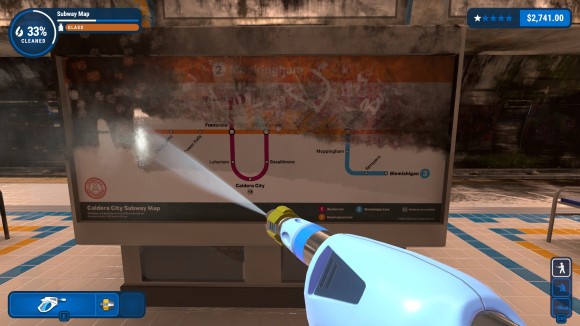
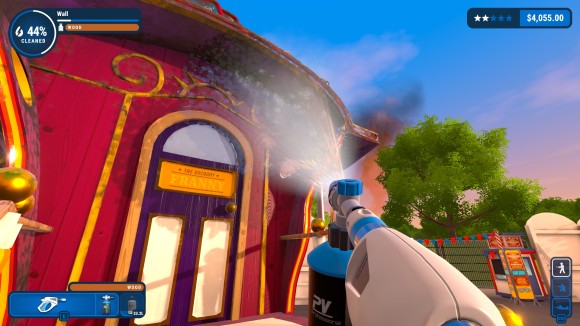
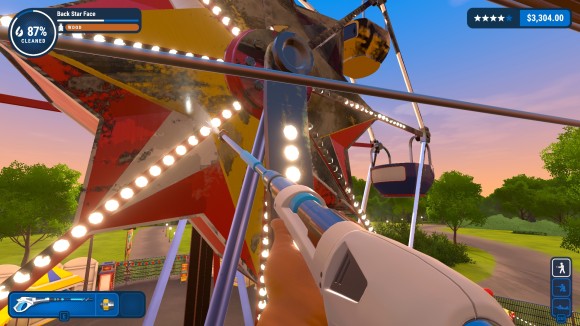
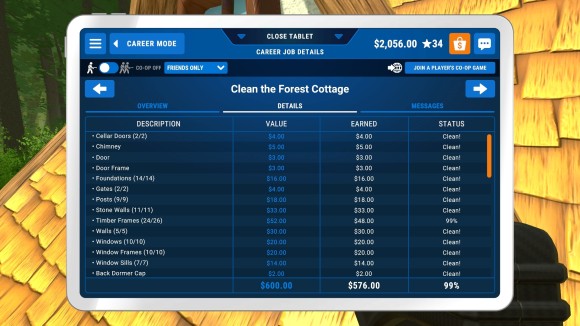
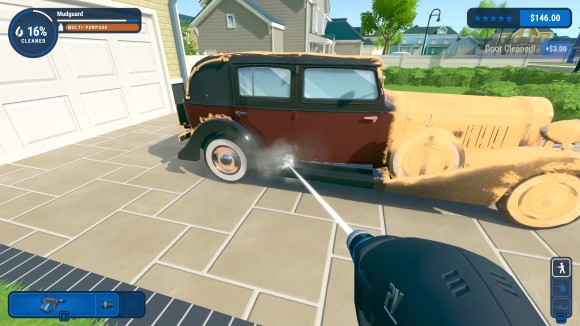
Where is the excess water/mud ?
Both water and dirt just vaporize.
In real life use of a PW, that’s always a huge part of the job…